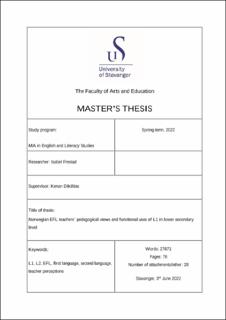| dc.description.abstract | Language use in the EFL classroom has been a controversial issue among language experts and practitioner-teachers (Sundari & Febriyanti, 2021). Although there are many related studies on L1 use in the EFL classroom, they primarily focus on the advantages and disadvantages, and on learners, less on teachers. To contribute to the arguments on this issue from the Norwegian context, this thesis investigates how three Norwegian lower secondary teachers use their L1 in the EFL classroom by exploring not only the functional uses of L1 through classroom observations, but also the corresponding pedagogical views as to the factors affecting their L1 use. By observing and interviewing teachers, the researcher aimed to address the following research questions: “How is the L1 used in the EFL classroom by lower secondary English teachers”, and “which factors do teachers recognize as affecting their use of L1 in the EFL classroom at the lower secondary level”.
The participants expressed in their interviews that they strive to use as much L2 as possible to maximize the pupils’ exposure to the language. However, they also expressed a need to include the L1. Findings showed that the L1 was used to introduce new vocabulary, code-switch, teach grammar, scaffold by adding L1 explanations, classroom management, solidarity, feedback, repetition, and check comprehension. L1 use often occurred in informal situations where the teacher conversed with pupils. The quantity of L1 use varied among the three participants, and from lesson to lesson. The variation seemed to be influenced by the type of activity or topic of the lesson. The factors the teachers recognized as influencing their L1 use are the pupils’ proficiency, the importance of a content, grammar instruction, important messages, classroom management and checking comprehension. In addition, code-switching was used both consistently and inconsistently by all three teachers. Whilst interviewing the teachers, it became evident that they were not always self-conscious of when they chose to use the L1 in relation to the observation categories: task instruction, feedback, translation, solidarity, classroom management, and grammar instruction. | |
